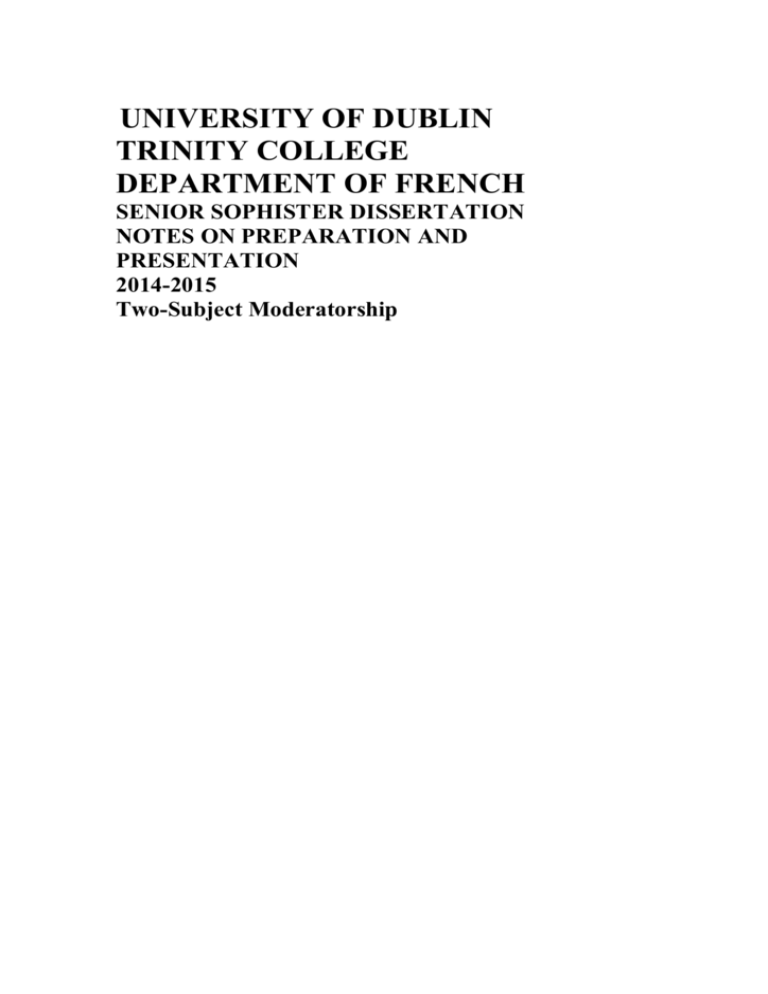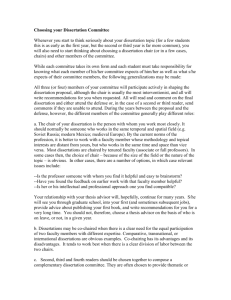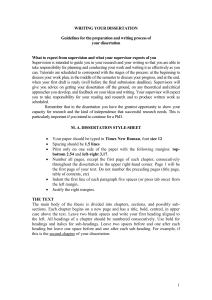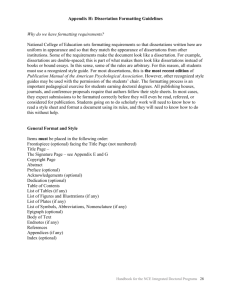French - Trinity College Dublin
advertisement

UNIVERSITY OF DUBLIN TRINITY COLLEGE DEPARTMENT OF FRENCH SENIOR SOPHISTER DISSERTATION NOTES ON PREPARATION AND PRESENTATION 2014-2015 Two-Subject Moderatorship SENIOR SOPHISTER DISSERTATION NOTES ON PREPARATION AND PRESENTATION 1. Those students taking Moderatorship Part II in French will already have experience of presenting extended written work in the form of their Freshman and Junior Sophister assessed essays. However, the following differences between these earlier assessed essays and a Senior Sophister dissertation should be noted: (a) The longer length of the dissertation (9,000-12,000 words) means that greater care is required in the selection of the topic, the organisation of the work, and the structuring and presentation of the material. (b) The dissertation, which should provide the reader with some insight into the techniques of research work, should aim at presenting something new, whether by means of a new approach to well-known material, or by analysis of new material. 2. Students are required to obtain the agreement of an appropriate supervisor for a provisional definition of subject area by the end of Hilary Term in their Junior Sophister year. They should, however, make use of the remainder of that term to consult further with a view to closer definition of the subject, and should expect to start working on the dissertation during the summer vacation. Dissertations must be submitted by 2 nd March 2015. 3. The dissertation should comprise the following elements: (a) Title-page: giving title, name of author, name of supervisor and year of submission. (b) Table of Contents: listing Introduction, chapter titles, conclusion and bibliography, with page numbers. (c) Introduction: setting out briefly (no more than 250 words) the objectives and scope of the dissertation and the general shape of the argument, together with some statement of how the work relates to studies already available. (d) Text, set out in chapters: divided as most appropriate to the material. (If sub-sections to chapters are used, these should be given separate headings and listed in the Table of Contents.) (f) Conclusion: summarising the results of your investigations, indicating their significance, setting them in a wider context and perhaps indicating possible future explorations. (g) Bibliography: listing all primary and secondary sources consulted (for reference methods, see 13 below). 4. Three copies of the dissertation should be prepared, two for submission to the Department, and one for retention by the candidate. It is worth remembering that discussion of the dissertation (conducted in French) constitutes fifty per cent of the Moderatorship Part II viva voce examination. Candidates are therefore advised to re-read their dissertations carefully before presenting themselves for the viva voce. 5. The dissertation should be typed, with double spacing (inset quotations in single spacing) on one side only of A4 white paper. Ample margins should be used, and the typing should be reasonably consistent in the length of line and the number of lines per page. The pages should be numbered consecutively. A plastic spiral binding is required. 6. Notes may appear as footnotes, as notes following a chapter, or together at the end of the dissertation. Whichever method is used, reference numbers to the notes should appear at the point in the text which relevance dictates, above the line, without punctuation. Notes are intended primarily for documentation and for citation of sources; they should not normally include extra expository material, which should be included in the text or, in exceptional cases, added as an appendix. Footnotes should rarely be used in linguistics dissertations. 7. Titles of books and other writings: (a) In English, the initial letters of the first word and of all subsequent principal words (i.e. excepting articles, prepositions and conjunctions) are capitalised: A Tale of Two Cities Rosencrantz and Guildenstem Are Dead (b) In French, only the initial letters of the first word and of proper names are capitalised, unless the first word is an article, when the first noun and any preceding adjective take an initial capital: Histoire de la peinture en Italic La Grande Peur dans la montagne (c) In all other modem European languages, capitalisation in titles follows the rules of capitalisation in normal prose in that language. 8. Quotations Lay-out of quotations differs according to length: (a) Short quotations (less than about 60 words of prose or less than two complete lines of verse) should be enclosed within single quotation marks and run on with the main text. (b) Longer quotations should be inset in single spacing, starting on a new line, without quotation marks. A quotation occurring within such a long quotation should be in single quotation marks; if a further quotation occurs within that, double quotation marks should be used. The following example illustrates these conventions: The prediction makes it clear that it is Julien's 'coeur feroce' which will end by making him a parricide (rather than accident or fate): and the effect on Julien is to inspire the fear not so much of accidentally killing his parents as of experiencing a conscious desire to do so: Sa prediction 1'obsedait; il se debattait contre elle. 'Non! non! non! Je ne peux pas les tuer!' puts il songeait 'Si je Ie voulais, pourtant?...' et il avait peur que Ie Diable ne lui en inspirat 1'envie. 9. References: the following examples show the normal conventions for citation in literary dissertations: (a) Books Yvonne Bellenger, Du Bellay: Ses 'Regrets' qu'il fit dans Rome (Paris, Nizet, 1975), pp. 23-4. Samuel Beckett: The Art of Rhetoric, edited by Edouard Morot-Sir, Howard Harper, Dougald McMillan III, North Carolina Studies in the Romance Languages and Literatures: Symposia, 5 (Chapel Hill, University of North Carolina Press, 1976). (b) Articles in books: Peter France and Margaret McGowan, 'Louis XIV and the Arts', in French Literature and its Background: The Seventeenth Century, edited by John Cruickshank, French Literature and its Background, 2 (London, Oxford, New York, Oxford University Press, 1969), pp. 82-98. (c) Articles in journals: Graham Chesters, 'Baudelaire and the Limits of Poetry', French Studies, 32, No. 4 (October 1978), pp. 420-34. N.B. In the bibliography at the end of the dissertation, the order is generally alphabetical by the surname of the author. Here, therefore, the surname of the author will precede his or her forename or initials: Koritz, L.S., Scarron saffrique (Paris, Klincksieck, 1977). 10. For linguistics dissertations please use the Harvard system of referencing. Department of French Academic Year 2014-2015










